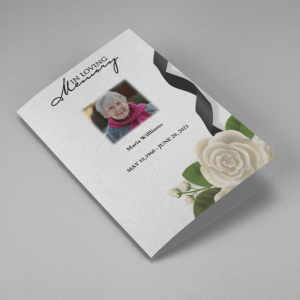Condolence messages are a meaningful way to express your sympathy to a friend or loved one who has lost someone close. The best condolence messages are handwritten on nice stationary and convey heartfelt sympathy. But how to you write such a letter? Here are some practical tips for writing a sympathetic condolence letter.
A friend or relative has recently passed away and you want to write a message of condolence to their family. You find a quiet place away from distractions. You get out the pen and paper, sit down to begin writing and…nothing happens. You’re mind goes blank. You may even begin to feel the pangs of grief yourself, and become a bit uncomfortable with the whole process. Maybe I’ll just send a quick email or e-card you think. Don’t worry, you’re quite normal.
An Email or Handwritten Condolence Message: Which is Best?
Writing a condolence message is not a pleasant task for anyone. Emails and e-cards have become an acceptable means of expressing condolences in our time. Yet a handwritten, heartfelt, short message of condolence can be so much more rewarding to both the recipient and the sender. Handwritten cards and letters are often left on display in the home of the grieving or kept as a remembrance. There’s also something about a person’s handwriting that conveys a deeper sense of feeling. So stick with your original plan, you’ll feel better afterwards, and so will the bereaved.
What to Write Your Condolence Message On?
Okay, now you’ve made up your mind to write a handwritten message. You begin to write, but there’s something about this red ink on the lined yellow notepad paper that just doesn’t look right. Good instinct! Losing a loved one is a very solemn occasion, so be as conservative and respectful as possible in choosing your increments and stationery or card.
Plain white paper is suitable, though something with a mellow, pastel type floral background or border will be quite soothing. A matching envelope and stationery will show the bereaved that you put some thought and genuine feeling into the process. Blue or black ink is preferable, though try to go with blue, there will be enough black at the funeral. Never Use a pencil. And by no means attempt to alleviate the earnestness of the occasion by sending a humorous card or trying to make light of death in your message.
Write out a Draft of Your Condolence Message First
Writing out a draft on scrap paper is a good way to make sure you say what you want to say. It’s also a good way to get out any jitters you might have about writing the message. It’s not easy to say exactly what you want the first time, so writing a draft on scrap paper will help you say exactly what you want to say. Once you have your condolence message written out and it sounds good, then get out the nice stationary and copy your final draft.
Use your Neatest Handwriting
For many this will be the first time experiencing death first hand or on such a personal level. It’s okay not to be sure what to do or how to go about it. Do be sure that when you begin to write, that you write legibly. A hastily or sloppily written condolence message will be difficult to read, and as heartfelt as it may be, will fail to impart the underlying emotion. Write slowly and clearly in order for your words to be truly felt. So take a deep breath, perhaps put on some soothing music, and begin your message.
How to Start Your Condolence Message?
The salutation is dependent on your relationship with the deceased. If he or she was a co-worker and you didn’t know the family, address the condolence message to the closest relative. If it is your friend who has lost a loved one, address the condolence message directly to him or her, not the family. A straightforward opening such as “I was so sorry to hear of the death of your loved one -or the deceased person’s name” is fitting.
What Else Should You Say in Your Condolence Message?
You needn’t write an essay on the life of the deceased. A brief expression of your condolences: letting them know your thoughts are with them, you’re sorry for their loss, is sufficient. If you knew the person well enough to share a happy memory, by all means do so. Offer help and be specific about it. When people are grieving they are in shock and often confused. Take the initiative to let them know you’ll be over to cook next week, or mow the lawn.
Ending Your Condolence Message
In closing, sum up your feelings with a sincere expression such as “my prayers are with you” or “my deepest sympathy”. Including a short poem or quotation that expresses your feelings can be a nice added touch, and help to express that which you might not be able to in a condolence message.
obituary message
Funeral Program Templates
-
Searching for a White Roses And Black Ribbon Funeral Program Template that is easy to print and has a cutting-edge look? White Roses And Black Ribbon Funeral Program Template is the Perfect decision because it measures 8.5”x 11”.
- No Limitation on Content, Edit anything
- Edit anytime – unlimited revisions even after purchased
- Get a printable PDF downloaded to get it printed on your own
-
Searching for a Realistic Burning Candle Funeral Program Template that is easy to print and has a cutting-edge look? Realistic Burning Candle Funeral Program Template is the Perfect decision because it measures 8.5”x 11”.
- No Limitation on Content, Edit anything
- Edit anytime – unlimited revisions even after purchased
- Get a printable PDF downloaded to get it printed on your own
-
Searching for a Bulltongue Arrowhead Funeral Program Template that is easy to print and has a cutting-edge look? Bulltongue Arrowhead Funeral Program Template is the Perfect decision because it measures 8.5”x 11”.
- No Limitation on Content, Edit anything
- Edit anytime – unlimited revisions even after purchased
- Get a printable PDF downloaded to get it printed on your own
-
Searching for a Grey Floral White Tiny Flower Funeral Program Template that is easy to print and has a cutting-edge look? Grey Floral White Tiny Flower Funeral Program Template is the Perfect decision because it measures 8.5”x 11”.
- No Limitation on Content, Edit anything
- Edit anytime – unlimited revisions even after purchased
- Get a printable PDF downloaded to get it printed on your own
-
Searching for a Red Flower Dark Soil Funeral Program Template that is easy to print and has a cutting-edge look? Red Flower Dark Soil Funeral Program Template is the Perfect decision because it measures 8.5”x 11”.
- No Limitation on Content, Edit anything
- Edit anytime – unlimited revisions even after purchased
- Get a printable PDF downloaded to get it printed on your own
-
Searching for a Pink Rose Frame Floral Oval Badge Funeral Program Template that is easy to print and has a cutting-edge look? Pink Rose Frame Floral Oval Badge Funeral Program Template is the Perfect decision because it measures 8.5”x 11”.
- No Limitation on Content, Edit anything
- Edit anytime – unlimited revisions even after purchased
- Get a printable PDF downloaded to get it printed on your own
-
Searching for a Brown and White Classic Funeral Program Template that is easy to print and has a cutting-edge look? Brown and White Classic Funeral Program Template is the Perfect decision because it measures 8.5”x 11”.
- No Limitation on Content, Edit anything
- Edit anytime – unlimited revisions even after purchased
- Get a printable PDF downloaded to get it printed on your own
-
Searching for a Purple Elegant Watercolor Funeral Program Template that is easy to print and has a cutting-edge look? Purple Elegant Watercolor Funeral Program Template is the Perfect decision because it measures 8.5”x 11”.
- No Limitation on Content, Edit anything
- Edit anytime – unlimited revisions even after purchased
- Get a printable PDF downloaded to get it printed on your own
-
Searching for a Cream and Green Photo Obituary Program that is easy to print and has a cutting-edge look? Cream and Green Photo Obituary Program is the Perfect decision because it measures 8.5”x 11”.
- No Limitation on Content, Edit anything
- Edit anytime – unlimited revisions even after purchased
- Get a printable PDF downloaded to get it printed on your own
-
Searching for a Cream Simple Elegant Photo Church Program that is easy to print and has a cutting-edge look? Cream Simple Elegant Photo Church Program is the Perfect decision because it measures 8.5”x 11”.
- No Limitation on Content, Edit anything
- Edit anytime – unlimited revisions even after purchased
- Get a printable PDF downloaded to get it printed on your own
-
Searching for a Grey Classic Minimalist Funeral Program Template that is easy to print and has a cutting-edge look? Grey Classic Minimalist Funeral Program Template is the Perfect decision because it measures 8.5”x 11”.
- No Limitation on Content, Edit anything
- Edit anytime – unlimited revisions even after purchased
- Get a printable PDF downloaded to get it printed on your own
-
Searching for a White Classic Funeral Program Template that is easy to print and has a cutting-edge look? White Classic Funeral Program Template is the Perfect decision because it measures 8.5”x 11”.
- No Limitation on Content, Edit anything
- Edit anytime – unlimited revisions even after purchased
- Get a printable PDF downloaded to get it printed on your own













